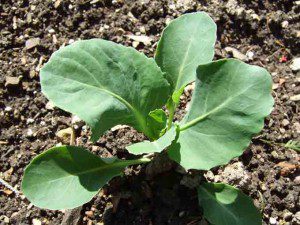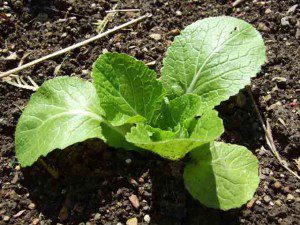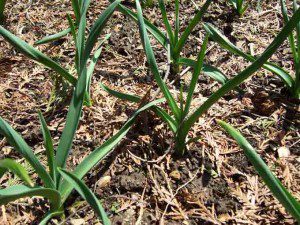Chris raises a veggie garden in Western Pennsylvania and e-mailed a couple weeks ago to inquire into the timing and types of vegetables to plant out in the garden during early spring:
“The weather it starting to warm up and be more consistent here in Pittsburgh now, so I am starting to plan my garden for this year.”
Getting the Veggie Garden Off to a Great Start
 “Last year, in the raised beds I put in thyme, oregano, rosemary, basil, onions, sage, lemon verbena, eggplant, strawberries, a variety of tomatoes and peppers and parsley. I didn’t really expect anything to survive the winter other than the oregano, maybe the sage and thyme and strawberries (which where covered with straw).”
“Last year, in the raised beds I put in thyme, oregano, rosemary, basil, onions, sage, lemon verbena, eggplant, strawberries, a variety of tomatoes and peppers and parsley. I didn’t really expect anything to survive the winter other than the oregano, maybe the sage and thyme and strawberries (which where covered with straw).”
“Anyway, the thyme, and I think the oregano (starting to see some green now), and the sage and strawberries made it thru the Pittsburgh winter. I am deciding what to plant this year and was looking for some suggestions. I thought maybe some lettuce and maybe carrots since they seem to be good spring crops. I already have my onion sets on and they are starting to sprout, as well as some garlic from the fall and I put some in about 3 weeks ago to see if I could get anything out in one year.”
“For the carrots I thought maybe St. Valery and for the lettuce Little Gem. I have seeds and was going to sow them directly soon, unless you thought it was to soon and I would sow them inside and transplant. Anyway, just wanted to thank you and see if I was off track or not. I will of course also grow my usual Roma tomatoes, rosemary, basil etc as usual once it gets warmer.”
Chris, I apologize for the delay in responding and I’m sure that a lot more greenery has been sprouting up in your garden by now. The weather has still not settled into springtime yet, and here in Central PA conditions are still on the chilly side and there were a few snow flurries just yesterday!
Perfect Vegetables to Plant Outside During Early Spring
 There are plenty of cold hardy, early spring crops that can be planted during March and April, but you are wise to hold off on the summer crops until things really warm up and the threat of frost is well past.
There are plenty of cold hardy, early spring crops that can be planted during March and April, but you are wise to hold off on the summer crops until things really warm up and the threat of frost is well past.
Beginning in mid to late March I start setting out transplants of the following cold tolerant vegetables:
- Lettuce – timing is critical for a successful harvest but you can’t beat the quality of fresh homegrown lettuce.
- Broccoli – plant in early spring and again in late summer for a fall harvest of tasty, sweet, florets.
- Collards – these greens tolerate the heat as well as the cold so you can keep it growing from spring right into the winter months.
- Kale – fast growth provides large quantities of delicious and nutritious leafy greens from a wide selection of diverse varieties.
- Kohl Rabi – an uncommon but easy to grow vegetable that deserves to be cultivated in more backyard gardens.
- Cabbage – try planting the smaller, compact varieties like Early Jersey Wakefield to produce nice heads before summer sets in.
- Globe Artichokes – a good choice for gardeners interested in growing something different that’s a bit of a challenge.
- Mustard – intensely flavored greens that come in a variety of colors, shapes, and degrees of spiciness.
- Oriental Greens – so many options to select from here including; Tatsoi, Pak-Choi, Chinese Cabbage, Mizuna, Bok Choy, and more.
All those veggies can withstand a brief cold spell and even a late snowfall shouldn’t pose much of a problem for them. I also direct seed parsnips, salsify, and Swiss Chard in early spring. Some gardeners rush their potatoes, carrots, and beets into the ground, which is okay, but I usually hold off a bit and plant them later with the intent of harvesting large roots for fall storage.
Even Earlier Harvests for the Anxious Vegetable Gardener
 I prefer to plant garlic and shallots in the fall, but they can also do fine as spring planted crops. Lettuce can be hesitant to germinate so I start some seed indoors in flats to transplant outdoors later, and sow the rest directly outdoors. Sprinkle lettuce seeds in the corner of a raised bed or cold frame during early spring and let them decide when the time is right to germinate. Once they’re up and have grown a few leaves, transplant them out into open spaces in the garden.
I prefer to plant garlic and shallots in the fall, but they can also do fine as spring planted crops. Lettuce can be hesitant to germinate so I start some seed indoors in flats to transplant outdoors later, and sow the rest directly outdoors. Sprinkle lettuce seeds in the corner of a raised bed or cold frame during early spring and let them decide when the time is right to germinate. Once they’re up and have grown a few leaves, transplant them out into open spaces in the garden.
The earliest spring harvests come from fall crops that over winter and resume growth at the end of winter. Loads of greens, spinach, and winter lettuces could all yield fresh produce from the garden about now. Then there are the leeks that survived the winter, roots such as parsnips that were left in the ground, and wild plants like dandelion and chickweed finding their way to the kitchen table.
The perennial and volunteer herbs are always a welcome sight as well, with bunches of chive leaves, tarragon, and chervil offering a sprig here and there as they awaken and push up new growth. Other good options to plant and get the garden off to a great start during spring include; onions, leeks, baby turnips, daikon radishes, peas, fava beans, and cauliflowers.



5 Responses
Hi Kenny,
Love the blog! Thanks for sharing your knowledge. What’s the best method for staking heirloom tomatoes? I’ve tried staking and tying but they always fall over, I’ve looked into rings but the reviews were mixed, and cages are expensive.
Thanks,
Cameron
Thanks Cameron, you’ve staked and tied, but have you also pruned your tomato vines to help ease the load? The cages are expensive, especially for the tall, heavy duty folding ones that I had been lusting after. This year I’m using a new staking technique that I learned this winter at the PASA conference. It’s simple, inexpensive, and incorporates pruning, mulching, and staking to manage the tomato vines. I’ll plan to post the details in an upcoming article here about staking tomatoes.
I am so anxious for a tomato. What is the first date anyone would set out a plant under a cloche? I’m in central Pa., zone 6.
Also, a Mother Earth News article mentioned filling tomato cages with straw and compost and securing the plants around the outside of the cages. I have the square, wire cages and may try this. It may help the falling over problem.
Cameron, I finally posted the tips on a new method for trellising tomatoes. Sorry it took so long but I wanted to include some video to make it perfectly clear how train tomato vines with this system. The info probably won’t help for this season but you may want to try it out next year and I will update the article to share the results of how this tomato trellising system works throughout the summer.